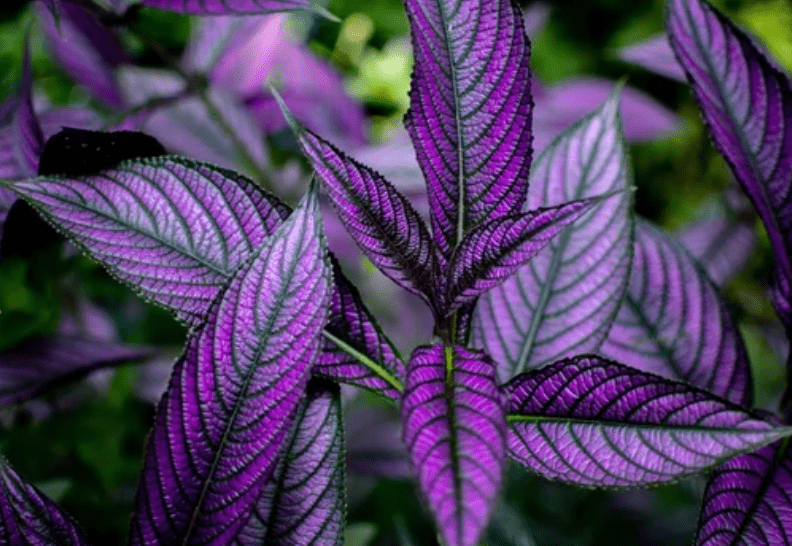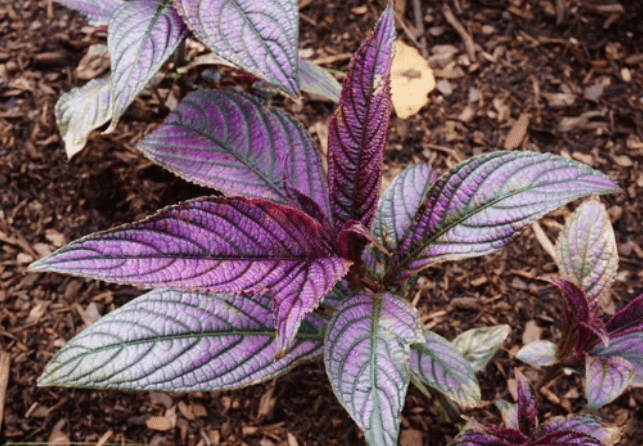
The Persian Shield Plant, scientifically known as Strobilanthes dyerianus, is an exquisite tropical gem that has captured the hearts of horticulturists and home gardeners alike. Its iridescent, almost otherworldly appearance sets it apart in any garden or indoor setting. Understanding this plant’s care and value is paramount for anyone keen on elevating their garden aesthetics or looking to dive into the world of vibrant houseplants.
History and Origin
Hailing from the sun-drenched shores of Myanmar, the Persian Shield has been a long-standing emblem of botanical wonder. Though the name might suggest a Middle Eastern origin, it’s said that the plant’s nomenclature refers to its shield-like leaves that shine with colors reminiscent of Persian tapestries. Its rich history and radiant hues have made it a coveted addition to gardens across the globe.
Distinctive Appearance
If ever a plant could be likened to nature’s kaleidoscope, the Persian Shield would be a worthy contender. Each leaf is a canvas painted with iridescent purple, silver, and deep green strokes. Sunlight only enhances this effect, as leaves shimmer and shift in hue, displaying a unique luminosity that few other plants can rival. Even the texture of the leaves – soft yet robust – beckons one to touch and feel the plant, adding a tactile dimension to its visual appeal.
Growing the Persian Shield Plant
Despite its regal appearance, the Persian Shield is surprisingly uncomplicated to care for. It thrives under bright, indirect sunlight, relishing the balmy temperatures between 60-75°F. Humidity is a friend to this tropical wonder; regular misting or a humidifier can work wonders. As for its roots, well-draining soil is critical. This ensures that the plant remains hydrated without becoming waterlogged. When watering, keeping the soil consistently moist but not overly saturated is crucial, ensuring its vibrant health.
Propagation Methods
Breeding new Persian Shield plants is an adventure in itself. Typically, propagation through stem cuttings proves most successful. Begin by snipping a healthy stem, ensuring it has several leaves attached. Plant this cutting in moist soil, ensuring it remains well-hydrated until roots form. With patience and consistent care, you’ll soon have a new generation of Persian Shield plants to admire.

Potential Pests and Diseases
Like any plant, the Persian Shield isn’t immune to pests and diseases. Aphids, spider mites, and whiteflies might sometimes like their luscious leaves. Regular inspection and natural insecticidal soaps can keep these at bay. Additionally, fungal diseases can be threatened if the plant sits in stagnant water. Ensuring proper drainage and avoiding over-watering is your best defense against such issues.
Landscape and Design Uses
In garden design, the Persian Shield is akin to a statement piece. Its vibrant hues make it a stand-out choice for borders, flower beds, or as a centerpiece in patio containers. For a harmonious garden palette, consider pairing it with lime-green plants like the sweet potato vine or even the golden hues of marigolds. Its versatility also shines in container gardening, adding color to porches or indoor spaces.
Benefits Beyond Beauty
While the Persian Shield is primarily celebrated for its aesthetic allure, whispers of its therapeutic properties circulate among herbal enthusiasts. Though not widely recognized in modern medicine, some cultures vouch for its potential soothing properties for skin ailments. Symbolically, in some societies, its vibrant leaves are seen as a sign of strength and endurance, resonating with its shield-like namesake.
Care Tips for Indoor Cultivation
Many enthusiasts cultivate the Persian Shield indoors, bringing its vibrant hues into their living spaces. When doing so, it’s vital to replicate its natural habitat. Ensure bright but indirect sunlight filters through, possibly through sheer curtains. Keeping the room’s humidity levels high will mimic its tropical origins. Regularly turning the plant ensures even growth and periodic fertilization can bolster its vibrancy.
What are the benefits of having a Persian Shield plant in your home or garden?
Having a Persian Shield plant in your home or garden not only adds a pop of vibrant color with its purple foliage, but it also has air-purifying properties. This plant can help improve indoor air quality by removing toxins and releasing oxygen, creating a healthier and more refreshing environment.
FAQ
-
How often should I water my Persian Shield Plant?
Keep the soil consistently moist, but avoid oversaturation.
-
Can the Persian Shield Plant survive winters outdoors?
It’s best suited for USDA zones 9-11. Consider bringing it indoors or treating it as an annual in colder regions.
-
Does the Persian Shield flower?
Yes, it produces small, inconspicuous flowers, but its primary appeal lies in its leaves.
Final Thoughts
The Persian Shield, or as botanists prefer, Strobilanthes dyerianus, is an emblematic foliage marvel hailing from Burma, reflecting shades of royal purple that remind us of sultry, humid air and warm temperatures. Fittingly known as the royal purple plant, its colorful foliage is a testament to nature’s artistry.
To achieve the best results in Persian Shield care, consider the native habitat of this specimen. These plants thrive in warm climates, and even warmer climates accentuate their vibrancy. These tropical plants bask under bright indirect light, making them excellent indoor plants, especially when hot temperatures or sultry humid air prevail.
However, while they love the heat, they appreciate moisture, making them a fan of frequent watering, especially when the soil mix – preferably a blend of compost, peat, and perlite – starts to dry about an inch from the top. Drainage holes are paramount; they prevent the roots from sitting in water, which could harm healthy growth.
Partial shade or dappled sunlight mimics their native environment, but they can also tolerate full sun. However, in cooler climates, protecting them from cold weather becomes crucial. In a nursery or browsing garden plants, the Persian Shield is often tagged as perennials in warmer regions and annuals in cooler areas.
Pruning, or pinching, encourages new growth, making the plant bushier and more vibrant. The best time to do this is midway between leaf nodes. And speaking of new growth, if you’re interested in propagation, taking cuttings from the mother or parent plant around the leaf node promises a high chance of success. Under the right conditions, these new plants often bloom with subtle purple flowers, though the bloom isn’t as attention-grabbing as the foliage.
Contrary to what its name might suggest, the Persian Shield isn’t native to Persia. However, the ‘shield’ in its name hints at its robust nature. Yet, even this easy plant, like ferns and other foliage favorites, can exhibit signs of nutrient deficiencies. A soil pH leaning neutral to slightly acidic, supplemented with controlled-release fertilizers rich in nitrogen, can work wonders.
The Persian Shield is a prime pick for enthusiasts hunting for garden plants with a touch of the exotic. Its roots trace back to the diligent work of botanists from Kew, who introduced this gem to plant lovers worldwide. Whether you’re a seasoned gardener or just stepping into the world of foliage, with the right care, this plant promises to transform spaces, blending the enchantment of its native tropical forests with the modern aesthetics of today.
In essence, whether you house it amongst ferns, place it as a centerpiece in your garden, or let it bask in warm temperatures indoors, the Persian Shield, with its shimmering hues, is a testament to nature’s unparalleled beauty.
With the proper care and a touch of love, this plant will thrive and become a talking point, making it a must-have for anyone keen on embracing the vibrant tapestry of nature.

























